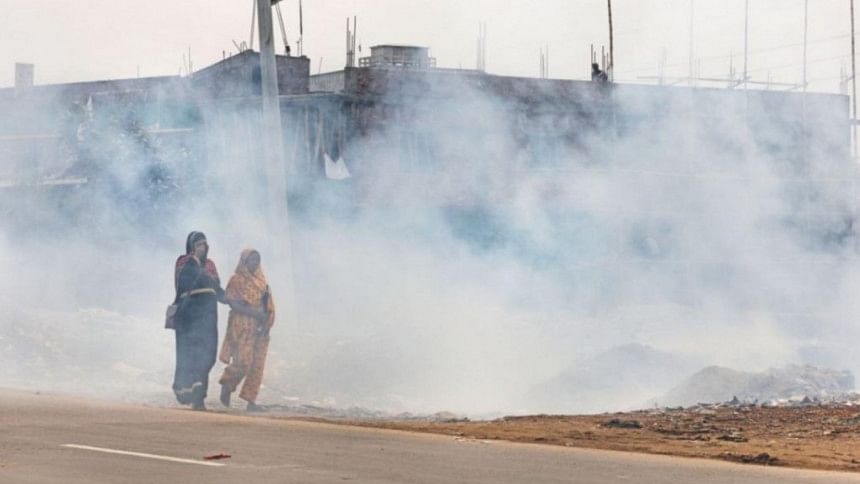Declare a ‘climate emergency’ to protect children

"Nero fiddles, while Rome burns" is an apt metaphor for the 25th world climate summit, called the Conference of Parties (COP25), which just ended in Madrid. Government representatives from 200 countries ended their meeting, copping out from agreeing on a pathway to implementing the 2015 Paris Agreement to limit global warming, carbon emission targets and other related measures.
Climate change specialist Saleemul Huq wrote that a big issue at COP25 was the role of children and civil society who urge that it is time to consider the climate change issue as a "climate emergency" ("COP25: Long but barely fruitful," TheDaily Star, December 18).
Greta Thunberg, the 16-year-old Swedish girl, named as the Time magazine's Person of the Year for her leading role in a worldwide youth mobilisation for climate action, spoke at the COP at its President's invitation. The negotiators listened politely but then went back to their endless arguments, ignoring her message of urgency to "make 2020 a year of action," because the coming decade will "define our future."
Environmental hazards for children
A conference on early childhood development attended by development organisations, experts and government representatives from the Asia Pacific Region in Hanoi, Vietnam, on December 4-6, was hosted by the Asia-Pacific Regional Network for Early Childhood (ARNEC). The conference raised an alert about climate change threats for young children and urged early action.
Fazilatunnesa Indira, MP, State Minister for Women and Children's Affairs, attended and addressed the meeting from Bangladesh. Besides describing the progress and initiatives about early childhood development in Bangladesh, she noted the climate-related dangers faced by the children and urged consideration of a climate alert for them.
The World Health Organization (WHO) has termed pollution of air as the silent killer which causes over eight million deaths of children per year worldwide. Children are more vulnerable than adults because children breathe more air, consume more food, and drink more water than adults in proportion to their weight.
Children's central nervous, immune, reproductive, and digestive systems are still developing. At this stage, exposure to environmental toxicants can lead to irreversible damage. The risk of autism spectrum disorder and neurodevelopmental disorder of children is increased by a pregnant mother's exposure to air pollution and toxic chemicals.
WHO estimates that environmental risks account for 25 percent of the disease burden in children under five. They are exposed to risk factors where they live, work, play and learn, unless preventive and protective measures are taken. ("Environment and Child Health," WHO, 2018)
Urban air pollution
Air pollution has become a major health threat in the larger cities of South Asia including Dhaka and it is getting worse. In a recent day (December 14 at 8:30 in the morning), Dhaka's air quality was the worst in the world, according to Air Visual, a US-based organisation that tracks air pollution. With a PM2.5 score of 237, it was by rank order above Ulan Bator in Mongolia, Kabul, Lahore and Chengdu in China, according to a report by a local newspaper on December 15.
PM2.5 score indicates the level of microscopic floating particles per cubic metre of air. A safe level is an average of 35 in 24 hours. Dhaka's air had almost 7.5 times more than the acceptable level of floating particulates in the air at least at one point in the day.
High levels of PM2.5 reduce visibility and cause the air to appear hazy. More dangerously, the tiny particles travel deep into the respiratory tract and the lungs and cause short-term eye, nose, throat and lung irritation; coughing, sneezing, runny nose; and shortness of breath. A prolonged exposure affects lung function and worsens medical conditions such as asthma and heart disease. It is associated with high rates of chronic bronchitis, reduced lung function and increased mortality from lung cancer and heart disease. Children and the elderly are particularly sensitive to PM2.5.
The sources of the fine particles primarily are exhausts from vehicles burning fossil fuels; other operations requiring burning of wood, coal and heating oil; construction activities; and natural sources such as forest and grass fires. Urban residents of Bangladesh are well familiar with these sources of air pollution, except the last one.
What can we do about it?
Much can be, and must be, done to halt the potential carnage and reverse the course. That a crisis is upon us has to be recognised and the obligation of the state and society has to be accepted to protect and nurture children. To do this, we need not depend on or wait for the global actors to put their acts together.
First, the Environment Ministry and the Ministry of Women and Children's Affairs need to work together to assess the depth and dimensions of the problem, and a framework for action has to be prepared containing strategies, plans and targets—immediate, short-term and longer-term for 5 to 10 years. Actually, the Comprehensive Policy for Early Childhood Care and Development adopted by the government in 2013 requires such cooperation and coordination.
Secondly, based on the framework for action, the concerned government ministries and agencies, government structures at city, municipality and local government levels, NGOs as well as community organisations and the private sector can examine and plan actions of their own. So should the educational institutions, health service providers and other social service agencies that serve children and families.
Thirdly, as part of the national and sub-national action plans, the enforcement of environmental safety rules and regulations and meeting all legal requirements by all concerned have to be ensured. The culture of inefficiency, neglect, absence of accountability and impunity for violations have to end. Shutting down illegal brick kilns which defy environmental regulations, enforcing dust, waste and noise control in construction sites, and taking off the street unfit vehicles spewing toxic fumes, among other initiatives, would make a significant difference in and around Dhaka.
Fourthly, monitoring mechanisms have to be established with the technical capacity to establish safety and protection benchmarks for major harmful sources and measure and monitor these. Remedial actions have to follow from the monitoring results. Setting up an independent environmental protection agency with the necessary technical capacity and mandate would be an appropriate step.
Fifthly, along with urgent actions under a climate alert to protect children, longer-term strategies, goals and plans also need to be guided by a sense of urgency. Adaptation and mitigation actions that we, as a state and society, need to take must be taken. Moving away from fossil fuel and coal as energy sources and fast-tracking into renewable sources, conserving the Sundarbans as a human heritage, making transportation and the built environment carbon-efficient, and generally actions for transition to sustainable production, consumption and lifestyle need not be at the mercy of decisions at COP summits.
Finally, citizens and civil society, academic and research institutions and the private sector need to recognise their social and moral obligation and stand up to do what need to be done for the future generations. As Greta Thunberg said, the adults are not taking their responsibilities, so children have to come out on the street. We should not let this happen.
Dr Manzoor Ahmed is professor emeritus at Brac University and chair of the Bangladesh ECD Network (BEN).

 For all latest news, follow The Daily Star's Google News channel.
For all latest news, follow The Daily Star's Google News channel. 



Comments